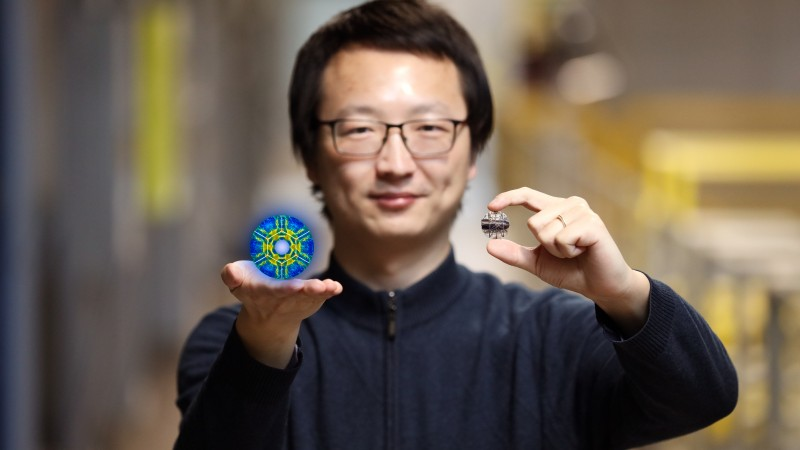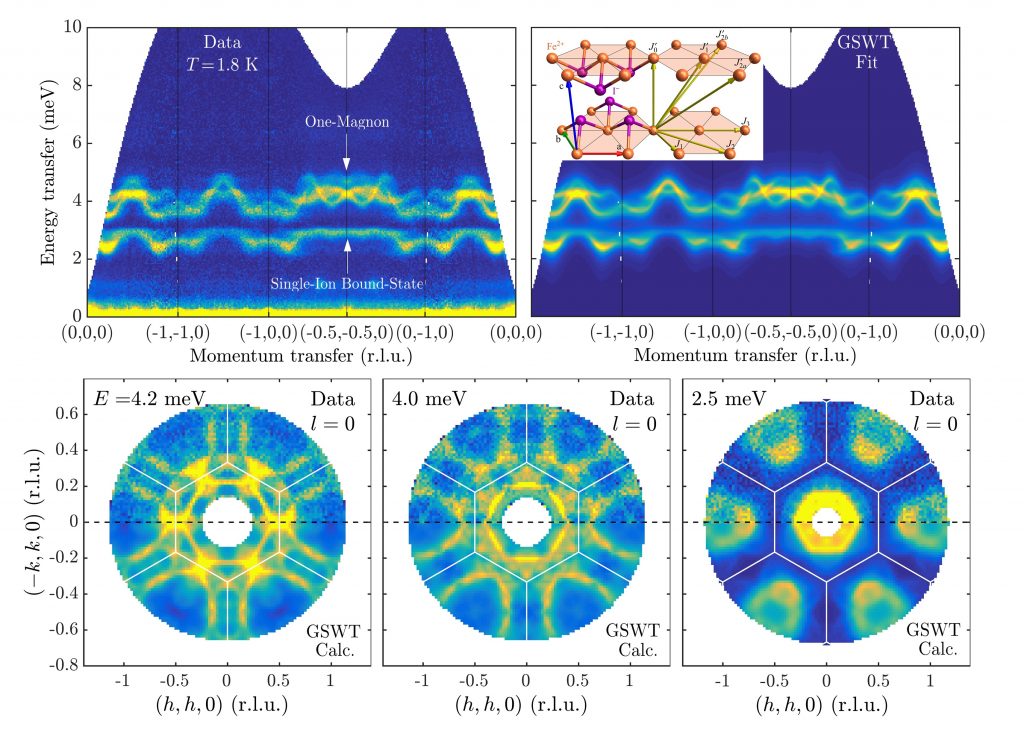April 4, 2021
Xiaojian Bai only knew Cristian Batista by reputation when he took a chance and sent him data from a Spallation Neutron Source experiment. The response came rapidly, followed by a phone call, and before long Bai was working with Batista and his group to demystify exotic states in quantum materials.
The connection seems simple enough: student and professor, both working in physics. Yet the pairing would have been unlikely under most circumstances. Bai was a graduate student at Georgia Tech interested in experimental physics. Batista holds a chaired professorship at the University of Tennessee, Knoxville, and is a distinguished theorist. The bridge between them was the Shull Wollan Center, whose infrastructure gives students and postdocs an opportunity to make important contributions to new science as it develops, crossing the divide between experiment and theory, young scientist and renowned researcher.

Perfect Timing
It all began when Bai was working with Martin Mourigal’s group at Georgia Tech, focusing on condensed matter and quantum materials.
“Martin encouraged all of his students to find their own interest. So that’s exactly what I did,” he said.
He dove into the scientific literature to find something that sparked his curiosity, preferably something that wasn’t understood well. That’s when he came across iron iodide, or FeI2. The compound had been studied in the 1970s and ’80s, and it has long been known that magnetic bound states exist in the material.
“We know it’s there, and people don’t know why,” Bai said. “I think partly (this is) because 40 or 50 years ago the experimental tools were not so developed, so we’re in the perfect time to revisit this problem.”
Bai went to the SNS and began studying iron iodide with inelastic neutron scattering experiments—where the neutrons probe changes in the material’s momentum and energy. He said he got a tremendous amount of information “that basically enabled us to answer this question of why we had observed exotic moments.”
The next question was what to do with it. One name came to mind.
“Cristian is a renowned theorist, so I probably heard his name sometime along the way doing my PhD,” Bai said. “I had heard from my colleagues who had worked with him that he is very enthusiastic about working with experimentalists and helping neutron scatterers to understand the data.”
He said he held onto the data for a couple of months and finally thought, “Why not just shoot an email to Cristian? (He) replied to me immediately and actually asked for my phone number and called me to tell me that this was exactly what he was looking for. We hit it off right away. When both sides are well-prepared, all we need is each other’s input.”
Hao Zhang, a graduate student in Batista’s UT group, and Postdoc Shang-Shun Zhang soon joined the work to put data and theory together.
“Hao and Cristian already had a theoretical framework in mind that was worked out many years ago but had not actually been put into use for any real material,” Bai said. “Hao and Shang-Shun developed the code and derived all the formulas and eventually did the calculations that showed that this could actually work.”
What they found were sharp quadrupolar excitations that typically don’t show up in neutron scattering measurements.
As Hao explained, “in conventional magnets when we think of excitations, people think of a classical moment, like a pencil pulsating around a certain axis. But in this system, besides these excitations, there are more exotic excitations, called the quadrupolar excitations, which cannot be described by this kind of pulsation. In essence, the length of this pencil can change, actually. It’s not a fixed length.”
Bai explained that in conventional behavior “you expect a magnet to form an ordered state; basically you have some magnetic moment sitting on each atom. At high temperature, they’re all pointing in random directions. At low temperature, they form some sort of long-range order pattern. For instance, they could all point toward the same direction.”
Over the past few decades, scientists who study quantum materials have been trying to find spin liquids, an exotic magnetic state of matter. Contrary to conventional behavior, spin liquids hold a disordered, short-range pattern at low temperature and the correlation between spins is more exotic.
“Our work is in a way going to a different direction,” Bai said. “This material is a long-range ordered state, but its excitation is not a conventional spin wave. We are trying to find new physics or exotic behavior from materials. That’s our hope, that through this work we’ll bring a different take to what people have often tried to pursue in the area of quantum materials.”

Digging out the Physics
The connection with Batista’s group is what brought this unconventional physics out of hiding. Otherwise, Bai would have had beautiful data but no interpretation for it.
“I think having the Shull Wollan Center inside Oak Ridge is really important because the SNS and the High Flux Isotope Reactor are user facilities,” Bai said. “So their primary job is to help users do experiments; to collect neutron scattering data.”
Borrowing an illustration from his colleague Matthew Stone, an instrument scientist at the SNS, Bai said that “quantum materials study is basically a triangle. One end is experiment. At the other end is materials synthesis. And the third point is theory or innovation. When we combine all three, we will have a successful study. The Shull Wollan Center basically provides the third point in this triangle. Without the theory, you can get really nice-looking data, but at the end of the day, you need to dig out the physics behind it. That’s where the theorists come in and help.”
Bai finished the PhD in 2019 and then joined ORNL as a postdoctoral associate. He continues his work with Batista’s group, advancing their studies to build on the original results. This is easier, he said, because they already have strong theoretical descriptors.
Consequently, “Hao and Shang-Shun and Cristian can predict what happens if you apply a magnetic field,” he explained. “They predicted there should be some exotic behavior. That prompted us to do a second experiment, and that is a successful story as well, because we did indeed find what they predicted.”
As a bonus, Bai invited Hao and Shang-Shun (now with the University of Minnesota) to come to the SNS and see the data stream in real time.
“The three of us were in front of the beamline,” Hao said. “We were very excited because we made some predictions, so we were in front of the instrument to see what would happen. When we saw these kind of excitations, we were very excited.”
Bai and Hao agreed that the collaboration is such that experiment and theory influence one another.
“Cristian provides a framework,” Hao said. “Then I do some simple derivations to show results. From that, I discuss with Cristian, so if he thinks this is right, I’ll do a full calculation. After that, we fit our results with experimentalists. So it’s kind of back-and-forth. Sometimes we will modify our theory to adapt to the experiments.”
Since they began working together, Hao and Batista have been meeting weekly with Mourigal and Bai. Their research was published in Nature Physics, with two more papers in the pipeline, and Mourigal and Batista wrote a proposal inspired by the project. Bai has since run two more experiments, slowly moving into a higher magnetic field to find additional magnetic phases and work toward perfecting their model.
“That’s another example that the experiment, the real data, is pushing us to a new frontier,” he said. “I think there’s new physics on the horizon emerging from this. We have a very nice team and working together on the subject will actually move this much faster than if we just work alone.”
An email. A phone call. A framework. A team. All leading to a deeper understanding of exciting physics in the quantum realm.
Or as Bai put it, “I think we achieve that one plus one is bigger than two.”
